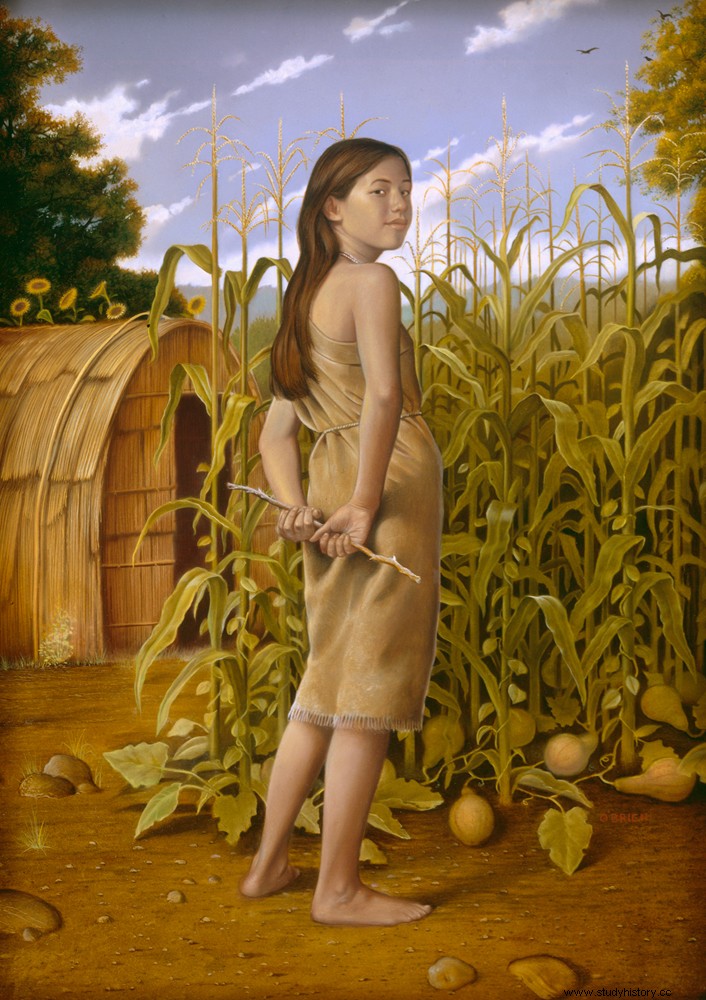Weetamoo, also known as Weetamoe, Namumpum or Tatapanunum (between 1635 and 1640-1676) was a Pocasset Wampanoag Native American chief.
Daughter of sachem
 Daughter of Sachem Corbitant, chief of the Pocassets, and one of his wives, Weetamoo was born between 1635 and 1640 in present-day Massachusetts. She has a younger sister, Wootonekanuske. Her father having no son, her quality of eldest makes her the heir to the role of sachem of the Pocassets.
Daughter of Sachem Corbitant, chief of the Pocassets, and one of his wives, Weetamoo was born between 1635 and 1640 in present-day Massachusetts. She has a younger sister, Wootonekanuske. Her father having no son, her quality of eldest makes her the heir to the role of sachem of the Pocassets.
Weetamoo grew up in the most important Pocasset village, Mettapoisett (now Cape Cod, Massachusetts). She learns hunting, fishing, swimming, cooking, tanning, as well as diplomacy. Supposed to become a sachem, Weetamoo passes in 1654 a rite of passage to adulthood normally reserved for boys, the quest for vision. The adolescent performing this rite must go alone into the forest and fast for several days, seeking communion with the fundamental spiritual energies, until the spirit of the child disappears.
The wedding with Wamsutta
A few years after his vision quest, Weetamoo marries Wamsutta, the elder of Massasoit, sachem of the Wampanoag tribes, of which the Pocassets are a part. Massasoit lives in peace with the colonists, a peace formalized by a treaty with the colony of Plymouth. The missionaries of the colony undertake to convert the local populations to Christianity and small communities begin to form, cutting the converts off from their original culture to impose Western culture on them.
In 1661, the death of Massasoit made his son, Wamsutta, the sachem of the Wampanoag tribes. As a sign of loyalty, he and his brother Metacomet took the names of Philippe and Alexandre respectively. The English settlers, however, did not like Wamsutta-Alexander, and when he was invited to Plymouth Colony, the sachem fell ill and died, probably poisoned. Weetamo, who had always been friendly with the settlers and who had integrated certain customs, conceived a great hatred for them.
King Philip's War
Metacomet-Philippe takes over from his brother and relations between the Wampanoag and the settlers become strained. In 1671, the English wrested a treaty of allegiance from the sachem, demanding that the warriors hand over their weapons and stipulating the submission of the tribes to the crown of England. Realizing that the English were unlikely to stop there, Metacomet-Philippe forged alliances with other tribes and worked to establish a supply of arms and ammunition, planning a revolt in 1676. But in 1675 the corps of a converted Indian is found and three Wampanoag warriors are arrested, tried and executed. The tension is such that Metacomet-Philippe can no longer hold back his men. On June 24, 1675, the first raids were launched against the enemies and the "King Philip's War" broke out.
Remarried in the meantime with a man named Petonowowett, Weetamoo leaves her husband when he allies himself with the English to join Metacomet-Philippe in his revolt. In particular, she obtains the command of three hundred men and leads attacks against the colonists. During the following year, the Wampanoag tribes and their allies attacked more than half of the English colonies and burned a dozen towns. On August 6, 1676, the English ambushed the Wampanoag. Six days later, Metacomet-Philippe, betrayed by one of his men, is killed. Settlers relentlessly hunt down Indian leaders and execute those they capture, including those who surrender.
Hunted like the others, Weetamoo loses her footing as she flees by the Tauton River and drowns. Found, his body is exposed in public.
Weetamoo is known today as "squaw sachem".
¹ I am not a specialist in the field, my apologies if I misinterpret or describe badly…
